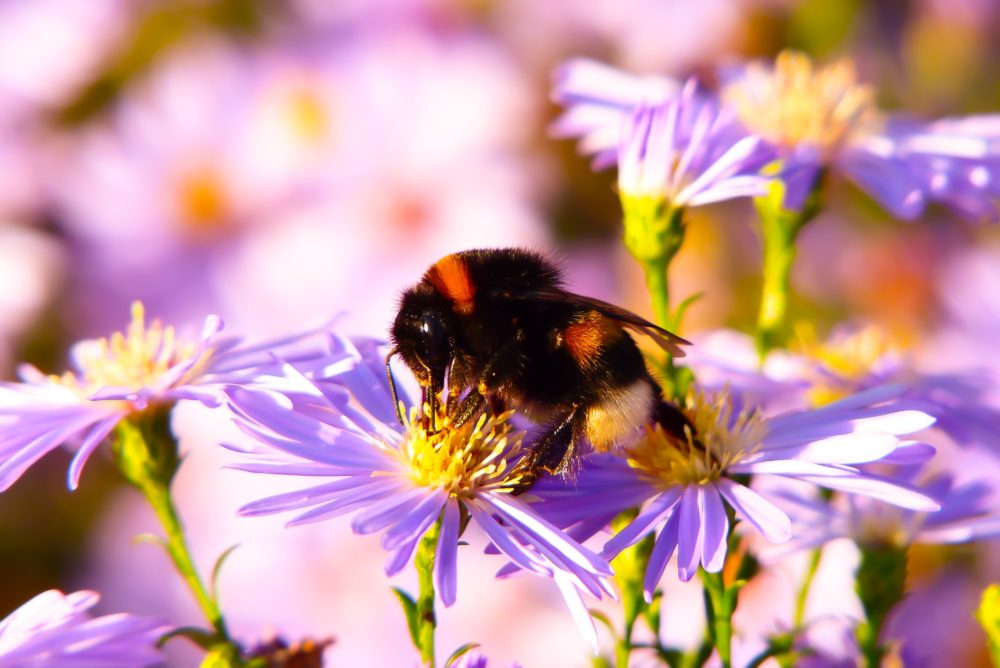As the climate crisis heats up, droughts, floods, and other natural disasters are making reliable food production increasingly difficult. But another, less discussed ecological issue is on track to join warming temperatures to create a perfect storm of food shortage: the collapse of honeybees.

The plight of honeybee colonies have been reported for the past several years—and it’s only getting worse. According to a new survey released by the Bee Informed Partnership, U.S. beekeepers lost nearly 40% of their colonies in the winter of 2018-2019—the highest number in 13 years.
Several factors contribute to the bee decline, such as loss of habitat, lowered crop diversity, parasitic mites, and pesticides. When pesticides like neonicotinoids lower bees’ immune systems, they are more susceptible to diseases that can lead to the demise of entire colonies. A study published in Ecology and Evolution shows that bees exposed to neonicotinoids can only fly a third of the distance unexposed bees can cover. This, in turn, reduces the area bees can forage for food by up to 80%. In 2016, a study published in Nature found that bees that fed on neonicotinoid-treated crops declined in greater numbers than those who visited untreated plants.
Due to mounting concerns over neonicotinoids, the EU has banned the use of the pesticide on bee-attractive crops in 2013. The situation is more complicated in the U.S., where the Trump administration has repealed an Obama-era policy banning the use of GMOs and pesticides, including neonicotinoids, at national wildlife refuges. This can affect not just commercial honeybees but thousands of invertebrate and wild bee species over millions of acres. Running parallel to the plight of honeybees is that of bumblebees, pollinators to tomatoes, strawberries, peppers, eggplants, watermelon, and potatoes that are fast disappearing in Europe and all along the West Coast of the United States. According to the Xerxes Society, an astonishing 28% of all North American bumble bees are facing extinction risk.
Honeybees, on the other hand, are said to be responsible for the fertilization of 85% of flowering plants, and 1 out of every 3 bites of food consumed by humans. If you are a vegan, it’s likely that the number is much higher. These crops include almonds, onions, celery, beets, broccoli, cauliflower, cabbage, orange, coconut, cucumbers, carrots, lemon, cotton, apples, avocados, all kinds of berries, and sesame, just to name a few. “If we want to continue to have a food supply that has the variety that we want, we need a movable pollination supply, and those are honeybees,” says Dennis vanEngelsdorp, associate professor of entomology at the University of Maryland and the president of the Bee Informed Partnership. “If we don’t have commercial beekeepers managing those, then we won’t be able to meet that demand.”
What can you do?
- Resist pesticide lobbying. Trump-appointed officials at the EPA and the USDA, and the members of the Congress have deep ties to pesticide lobbyists. Find out where your elected officials stand on pesticide issues.
- Support bee-friendly nonprofits. Some great organizations are working to protect the bees full-time, so you can keep working at your job! Check out Environment New York’s No Bees, No Food campaign, the Xerxes Society for Invertebrate Conservation, and the Honeybee Conservancy.
- Plant flowering plants! Bees are attracted to all sorts of flowers—and in my personal experience, bumblebees love purple flowers the best. Plant English lavender to bring all the bumble and honeybees to the yard (French lavender works too). Keep them organic and watch your local pollinators go happy.
___
Related:3 Keystone Species We Can’t Live Without—Here’s How You Can Help Save Them
The Decline of Honeybees and 5 Ways to Help
Need A Honey Substitute? These 10 Vegan Options Are Truly Buzz-Worthy (Wink)
Get more like this—Subscribe to our daily inspirational newsletter for exclusive content!
__
Photo: Krzysztof Niewolny on Unsplash




